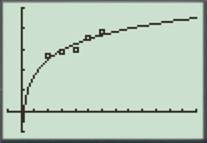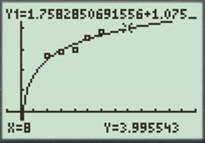
(a)
To find: The natural logarithm regression equation and a
(a)
Answer to Problem 49E
The natural logarithm regression equation is
Explanation of Solution
Given information: The table given below shows Natural gas production of a country in different years:
| Iran’s Natural Gas Production | |
| Year | Cubic Feet(trillions) |
| 2002 | 2.65 |
| 2003 | 2.86 |
| 2004 | 2.96 |
| 2005 | 3.56 |
| 2006 | 3.84 |
Calculation:
Assume that
To find the natural logarithm regression equation of the given data, use graphing calculator.
Step 1: Press
Step 2: List the input values 2, 3, 4, 5 and 6 in the L1 column.
Step 3: List the input values 2.65, 2.86, 2.96, 3.56 and 3.84 in the L2 column.
Step 4: Press the keystrokes
Now, to make the scatter plot, follow the steps using graphing calculator.
Step 1: Press
Step 2: Press
Step 3: Press the keystrokes

Figure (1)
Therefore, the natural logarithm regression equation is
(b)
To find: The estimated number of cubic feet of natural gas produced in 2008.
(b)
Answer to Problem 49E
The estimated natural gas produced in 2008 is 3.99 trillion cubic feet.
Explanation of Solution
Given information: The table given below shows Natural gas production of a country in different years:
| Iran’s Natural Gas Production | |
| Year | Cubic Feet(trillions) |
| 2002 | 2.65 |
| 2003 | 2.86 |
| 2004 | 2.96 |
| 2005 | 3.56 |
| 2006 | 3.84 |
Calculation:
To find the natural gas produced in 2008, find the value of y at
Press

Figure (2)
From the graph it can be seen that the value of rom the graph it can be seen that the value of y is 3.995543.
Therefore, the estimated natural gas produced in 2008 is 3.99 trillion cubic feet.
(c)
To find: The year in which natural gas production reaches to 4.2 trillion cubic feet.
(c)
Answer to Problem 49E
In the year 2010 the natural gas production reaches to 4.2 trillion cubic feet.
Explanation of Solution
Given information: The table given below shows Natural gas production of a country in different years:
| Iran’s Natural Gas Production | |
| Year | Cubic Feet(trillions) |
| 2002 | 2.65 |
| 2003 | 2.86 |
| 2004 | 2.96 |
| 2005 | 3.56 |
| 2006 | 3.84 |
Calculation:
From the graph shown in part (b), estimated natural gas produced in 2008 is 3.99 trillion cubic feet.
So, it can be predicted that the production of natural gas reaches to 4.2 trillion cubic feet in 2010.
Therefore, in year 2010 the natural gas production reaches to 4.2 trillion cubic feet.
Chapter 1 Solutions
Calculus: Graphical, Numerical, Algebraic: Solutions Manual
Additional Math Textbook Solutions
A Problem Solving Approach To Mathematics For Elementary School Teachers (13th Edition)
Calculus: Early Transcendentals (2nd Edition)
Basic Business Statistics, Student Value Edition
Algebra and Trigonometry (6th Edition)
Elementary Statistics
Pre-Algebra Student Edition
- Force with 800 N and 400 N are acting on a machine part at 30° and 60°, respectively with the positive x axisarrow_forwardFind the accumulated amount A, if the principal P is invested at an interest rate of r per year for t years. (Round your answer to the nearest cent.) P = $13,000, r = 6%, t = 10, compounded quarterly A = $ 31902 Need Help? Read It Watch It Viewing Saved Work Revert to Last Response SUBMIT ANSWER O/6.66 Points] DETAILS MY NOTES TANAPCALC10 5.3.003. EVIOUS ANSWERS ASK YOUR TEACHER PRACTICE ANOTHER Find the accumulated amount A, if the principal P is invested at an interest rate of r per year for t years. (Round your answer to the nearest cent.) P = $140,000, r = 8%, t = 8, compounded monthly A = $259130.20 X Need Help? Read It Watch Itarrow_forwardFind the present value of $20,000 due in 3 years at the given rate of interest. (Round your answers to the nearest cent.) (a) 2%/year compounded monthly (b) 5%/year compounded daily $ Need Help? Read It Watch It SUBMIT ANSWER [-/6.66 Points] DETAILS MY NOTES TANAPCALC10 5.3.009. ASK YOUR TEACHER PRACTICE ANC Find the accumulated amount after 3 years if $4000 is invested at 3%/year compounded continuously. (Round your answer to the nearest cent.) Need Help? Read It Watch Itarrow_forward
- Find the effective rate corresponding to the given nominal rate. (Round your answers to three decimal places.) (a) 9.5%/year compounded monthly % (b) 9.5%/year compounded daily % Need Help? Read It Watch It SUBMIT ANSWER -/6.66 Points] DETAILS MY NOTES TANAPCALC10 5.3.007. ASK YOUR TEACHE Find the present value of $90,000 due in 7 years at the given rate of interest. (Round your answers to the nearest cent.) (a) 9%/year compounded semiannually (b) 9%/year compounded quarterly LAarrow_forwardFind the accumulated amount A, if the principal P is invested at an interest rate of r per year for t years. (Round your answer to the nearest cent.) P = $160,000, r = 7%, t = 4, compounded daily A = $211113.60 Need Help? Read It SUBMIT ANSWER ASK YOUR TEACHER PRACTICE ANOTHER --/6.66 Points] DETAILS MY NOTES TANAPCALC10 5.3.005. Find the effective rate corresponding to the given nominal rate. (Round your answers to three decimal places.) (a) 8%/year compounded semiannually % (b) 9%/year compounded quarterly %arrow_forwardFind the derivative of the function. g'(t) = 9t g(t) = In(t) (9ln(t) - 1) [In(t)] 2 × Need Help? Read It Watch Itarrow_forward
- Find the accumulated amount A, if the principal P is invested at an interest rate of r per year for t years. (Round your answer to the nearest cent.) P = $3800, r = 4%, t = 10, compounded semiannually A = $ 5645.60 × Need Help? Read It SUBMIT ANSWER [3.33/6.66 Points] DETAILS MY NOTES REVIOUS ANSWERS ASK YOUR TEACHER TANAPCALC10 5.3.001.EP. PRACTICE ANOTHER Consider the following where the principal P is invested at an interest rate of r per year for t years. P = $3,100, r = 4%, t = 10, compounded semiannually Determine m, the number of conversion periods per year. 2 Find the accumulated amount A (in dollars). (Round your answer to the nearest cent.) A = $ 4604.44arrow_forwardForce with 800 N and 400 N are acting on a machine part at 30° and 60°, respectively with a positive x axis, Draw the diagram representing this situationarrow_forwardI forgot to mention to you to solve question 1 and 2. Can you solve it using all data that given in the pict i given and can you teach me about that.arrow_forward
 Calculus: Early TranscendentalsCalculusISBN:9781285741550Author:James StewartPublisher:Cengage Learning
Calculus: Early TranscendentalsCalculusISBN:9781285741550Author:James StewartPublisher:Cengage Learning Thomas' Calculus (14th Edition)CalculusISBN:9780134438986Author:Joel R. Hass, Christopher E. Heil, Maurice D. WeirPublisher:PEARSON
Thomas' Calculus (14th Edition)CalculusISBN:9780134438986Author:Joel R. Hass, Christopher E. Heil, Maurice D. WeirPublisher:PEARSON Calculus: Early Transcendentals (3rd Edition)CalculusISBN:9780134763644Author:William L. Briggs, Lyle Cochran, Bernard Gillett, Eric SchulzPublisher:PEARSON
Calculus: Early Transcendentals (3rd Edition)CalculusISBN:9780134763644Author:William L. Briggs, Lyle Cochran, Bernard Gillett, Eric SchulzPublisher:PEARSON Calculus: Early TranscendentalsCalculusISBN:9781319050740Author:Jon Rogawski, Colin Adams, Robert FranzosaPublisher:W. H. Freeman
Calculus: Early TranscendentalsCalculusISBN:9781319050740Author:Jon Rogawski, Colin Adams, Robert FranzosaPublisher:W. H. Freeman
 Calculus: Early Transcendental FunctionsCalculusISBN:9781337552516Author:Ron Larson, Bruce H. EdwardsPublisher:Cengage Learning
Calculus: Early Transcendental FunctionsCalculusISBN:9781337552516Author:Ron Larson, Bruce H. EdwardsPublisher:Cengage Learning





